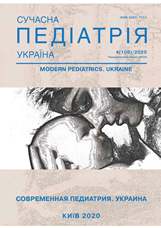Mathematical model of sepsis of newborn, whose parents lived in places of different environmental situation
Keywords:
neonatal sepsis, ecological risk coefficient, mathematical modelAbstract
Purpose — to create a mathematical model of newborns with neonatal sepsis whose parents lived in places with different environmental conditions with further improvement of sepsis management of newborns whose parents lived in places with unfavorable environmental conditions.
Materials and methods. We examined 260 newborns with neonatal sepsis, whose parents lived in different environmental conditions. The proposed environmental risk factor (CER) taking into account the environmental situation in the regional centers was a group-forming feature of a comprehensive assessment of the long-term burden on the body of parents of newborns of anthropogenic pollution of air, water and soil in the regions.
Results. The analysis of the relationship between the indicators of a comprehensive examination of patients with sepsis showed that there is a probable connection between the environmental situation of the parents of newborns, risk factors for neonatal sepsis and its clinical and laboratory manifestations. It is established that in the created mathematical model of severity of sepsis of newborns whose parents lived in places of the increased ecological risk, the main components of the main factors were KER, small gestational age, risk factors of early and late sepsis, indicators of metabolic and respiratory acidosis, the increased content of blood. -8 and multiorgan dysfunction, as well as the presence of apoptosis.
Conclusions. The mathematical model of neonatal sepsis, created by multifactor correlation analysis, indicates the presence of two phenotypes of neonatal sepsis, which are based on the ecological characteristics of the habitats of parents of sick children, which will further create a neonatal sepsis management algorithm.
The study was conducted in accordance with the principles of the Declaration of Helsinki. The research protocol was approved by the Local Ethics Committee of the institution indicated in the work. Informed consent of parents of children was obtained for the research.
References
Anderson–Berry AL, Bellig LL, Ohning BL, Rosenkrantz T et al. (2015). Neonatal Sepsis. Medscape Video NEW Clinical. Cited 2017 Sept 19. URL: http://emedicine.medscape.com/article/978352-overview.
Fazzo L, Minichilli F, Santoro M, Ceccarini A et al. (2017, Oct.). Hazardous waste and health impact: a systematic review of the scientific literature. Environmental health. 16: 107. https://doi.org/10.1186/s12940-017-0311-8; PMid:29020961 PMCid:PMC5637250.
Fleischmann–Struzek C, Goldfarb DM, Schlattmann P, Schlapbach LJ, Reinhart K, Kissoon N. (2018, Mar). The global burden of paediatric and neonatal sepsis: a systematic review. Lancet Respir Med Lancet Respir Med. 6 (3): 223-230. https://doi.org/10.1016/S2213-2600(18)30063-8.
Genowska A, Jamiolkowski J, Szafraniec K, Stepaniak U, Szpak A, Pajak A. (2015). Environmental and socio-economic determinants of infant mortality in Poland: an ecological study. Environmental health. 14: 61. https://doi.org/10.1186/s12940-015-0048-1; PMid:26195213 PMCid:PMC4508882.
Kamalakannan SK. (2018). Neonatal Sepsis Past to Present. Biomed J Sci. Tech Res. 3 (3): 1-6. URL: https://biomed res.us/pdfs/BJSTR.MS.ID.000909.pdf. https://doi.org/10.26717/BJSTR.2018.03.000909.
Kihal–Talantikite W, Zmirou–Navier D, Padilla C, Deguen S. (2017, May). Systematic literature review of reproductive outcome associated with residential proximity to polluted sites. International journal of health geographics. 16: 20. https://doi.org/10.1186/s12942-017-0091-y; PMid:28558782 PMCid:PMC5450119.
Kouassi B, Horo K, Gode C, Ahui B, Kouassi MN, Koffi N et al. (2015). Clinical manifestations in patients exposed to an environmental toxic accident (Abidjan, Ivory Coast 2006). Rev Mal Respir. 32 (1): 38–47. https://doi.org/10.1016/j.rmr.2014.01.015; PMid:25618203.
Shane AL, Stoll BJ. (2014). Neonatal sepsis: progress towards improved outcomes. J Infect. 68 (1): 24–32. https://doi.org/10.1016/j.jinf.2013.09.011; PMid:24140138.
Singer M, Deutschman CS, Seymour CW, Shankar–Hari M, Annane D, Bauer M et al. (2016). The Third International Consensus Definitions for Sepsis and Septic Shock (Sepsis-3). JAMA. 315 (8): 801–810. https://doi.org/10.1001/jama.2016.0287; PMid:26903338 PMCid:PMC4968574.
Statystychnyj shhorichnyk Chernivecjkoji oblasti za 2017 rik. (2018). Za red. T.Gh Sarchynskoi. Chernivci: 543.
Statystychnyj shhorichnyk Khmeljnycjkoji oblasti za 2017 rik. (2018). Za red. LO Khamskoi. Khmeljnycjkyj: 514.
Downloads
Published
Issue
Section
License
The policy of the Journal “MODERN PEDIATRICS. UKRAINE” is compatible with the vast majority of funders' of open access and self-archiving policies. The journal provides immediate open access route being convinced that everyone – not only scientists - can benefit from research results, and publishes articles exclusively under open access distribution, with a Creative Commons Attribution-Noncommercial 4.0 international license (СС BY-NC).
Authors transfer the copyright to the Journal “MODERN PEDIATRICS. UKRAINE” when the manuscript is accepted for publication. Authors declare that this manuscript has not been published nor is under simultaneous consideration for publication elsewhere. After publication, the articles become freely available on-line to the public.
Readers have the right to use, distribute, and reproduce articles in any medium, provided the articles and the journal are properly cited.
The use of published materials for commercial purposes is strongly prohibited.

